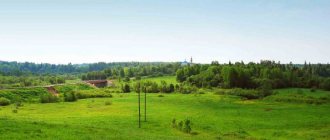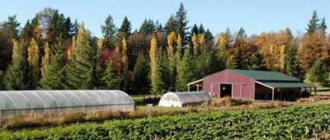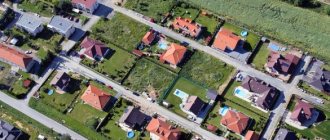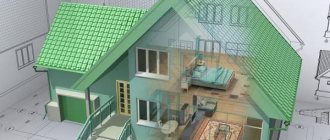According to the legislation of the Russian Federation, lands of populated areas (LNP) include areas located in the populated area itself or in the territory adjacent to it. The main task of these lands is the development of the city or settlement to which they belong. Residential buildings and public facilities are being built on such lands.
However, building a residential building or farming a subsidiary plot is not permitted on all plots. The reason for this is that all lands of settlements are distributed according to destination groups. So, if the site is intended for cattle breeding or gardening, then a commercial facility built on it will be considered illegal. For the owner of the building, this status means demolition, as well as a fine of 1% of the value of the site. In this case, the amount of the fine cannot be less than 10 thousand rubles.
To avoid such situations, it is necessary, even before construction, to find out everything about the purpose and type of permitted use of the site. This is easy to do, just know the cadastral number of the land and find the plot on the Rosreestr website (rosreestr.ru). Or send a corresponding request to local authorities. We will tell you how to do this correctly in this article.
What it is?
Land legislation provides for seven categories into which plots of land can be divided. This document gives the concept of lands belonging to settlements. It is indicated that such plots are those that do not extend beyond the boundaries of the populated area.
The purpose of such lands is to develop infrastructure and carry out construction work. The types of permitted land use are specified in a specially developed classifier. The boundaries of territories are indicated in legislative acts. Some subjects have the authority to change them.
The concept of NP lands
These include:
- bodies carrying out government activities at the federal level;
- local authority;
- judicial authorities.
Borders
A boundary is a “line” that separates a populated area from other types of land.
The boundaries of the NP should be located so that there are no overlaps between the boundaries of municipalities and areas that are allocated to anyone.
Both the initial approval of the boundaries of the NP and their changes are recorded in the main documents of municipalities.
Depending on the municipality, such a document may be:
- general plan,
- territorial planning schemes.
of cities with special status are changed :
- Moscow,
- St. Petersburg,
- Sevastopol.
They are approved by the Federation Council .
If some plot from one NP “moved” to a neighboring one, then this does not entail any changes in the rights to this plot.
Lands of other categories cannot be included in the territory of a settlement , therefore the transfer of boundaries involves a change in the category of land (either adjacent lands become NP lands, or NP lands move to another category).
Along the perimeter of the settlement there is a suburban zone ; it is not included in the territory of the settlement, but is, as it were, a “spare” zone in case of expansion of the NP.
Not every space is suitable for creating a settlement. For example, this applies to flooded lands and areas where attempts are being made to preserve wildlife.
Composition and zoning
The urban planning documentation, which is established for each region, prescribes the composition of lands related to settlements. The composition includes the following groups of territories related to zones:
- zones of location of buildings intended for residence;
- territories with industrial purposes;
- lands intended for the location of transport schemes and engineering;
Land composition - agricultural land;
- recreational allotments;
- territories with special purposes;
- lands intended for the construction of objects with military purposes.
Rules regarding land use and development are prescribed in urban planning acts, which are provided for each type of territory individually. In this case, the nuances regarding the development and location of plots must be taken into account, and their capabilities in relation to the combination of different types of use of plots are also important.
If the land is located in a residential area, then only residential buildings can be erected on it; objects with domestic, cultural and other purposes can also be located.
When it comes to the lands of the public and business zone, its purpose is the construction of administrative buildings, objects that have social, educational, social, domestic and other meanings. Industrial zones are subject to development with production and other facilities that can be built in accordance with legislative acts.
Land protection
Land protection in populated areas is the activity of state authorities, local governments, legal entities and individuals, aimed at preserving land as an important component of the environment and natural resource. This entire complex is aimed at maintaining and restoring the normal quality of land in populated areas. It must be favorable for human life and health. The lands of populated areas should be used rationally: for the placement of residential, public and business, cultural and recreational, household and other buildings. All this is necessary for the sustainable development of settlements in the Russian Federation. There are 4 measures of responsibility for improper protection of land in populated areas:
- Disciplinary – regulated by the Labor Code of the Russian Federation. Provides for the following types of punishment: reprimand, reprimand, transfer to a lower-paid job or dismissal.
- Administrative – regulated by the Town Planning Code of the Russian Federation. Provides for punishment in the form of a fine.
- Criminal – regulated by the Criminal Code. In practice, this type of punishment does not occur.
- Property – consists of compensation for environmental damage in full. The authorities may decide to pay compensation or confiscate.
Lands of settlements are the most important category in the land fund of the Russian Federation. Its legal regime is determined by the Land Code adopted in 1998. In practice, many regulations are not applied due to lack of implementation. There is also insufficient protection of land: too small fines do not stop people from violating the law.
Kinds
The permitted use for the category of land in question is established in a special classifier. All plots related to settlements can be conditionally divided into zones by territory.
Indicate areas such as:
- location of residential buildings;
- buildings of a public and business nature;
- for conducting business activities;
- use for public purposes;
- organization of recreation.
Legal regime of lands
The above zones include several types of use. Including:
- Residential areas include those uses that involve the construction of residential buildings. According to the classifier, they include:
- houses built like townhouses (blocked type);
- high number of storeys includes the construction of buildings above 8 floors;
- average number of storeys – up to 8.
tent cities – this means a mobile variety;
Individual residential buildings, for example, cottages, private houses, etc., can also be built. In addition, the construction of buildings for domestic purposes, such as a garage and utility room, is allowed. The possibility of running a personal subsidiary plot with the construction of a private house for this purpose is provided. In this case, a person must have a main goal - growing a vegetable garden, orchard or livestock.
Signs of NNP
Lease of land from the administration for development
To rent a plot for individual housing construction, you need to complete the following steps:
- Order a copy of the site plan on a scale of 1:500 from the city administration.
- Select a site without objects under construction.
- Find out from the local administration whether it is possible to rent this plot of land.
- Make sure that there are no objects on the site that would impede construction.
- Submit a development application.
It may take several weeks for the authority to make a decision. If the consideration of the application is positive, an auction is held. A notice about it is published in the media and on the Internet.
Private household plots
On plots that are allocated for personal subsidiary farming, the construction of residential buildings is allowed. Rules are established regarding their number of floors - no more than three. In this situation, garages and utility rooms are also not subject to accounting. Particular emphasis is placed on the fact that the house can only be single-family.
On the site having the intended purpose, livestock breeding, gardening and gardening are allowed.
The attention of the land user is drawn to the fact that subsidiary farming in relation to agricultural lands and lands related to settlements are completely different and have different permitted uses.
In the latter case, the construction of houses can be carried out without restrictions, but in another situation, discussed above, approval is required from the commission involved in land use activities. A requirement is also established that the allotment must be used on an ongoing basis in accordance with its intended purpose and must be processed.
Advantages of plots for individual housing construction
The main advantages of plots for individual construction lie in the specific design of the housing built on them. This issue was partially touched upon above, but it is worth clarifying some points.
- Purchasing land for building a house is accompanied by significant costs for the construction of the structure. If, due to a lack of funds, you have to turn to the bank for a loan, the financial institution will provide a large loan secured by a plot of land for individual housing construction.
- Since the plots of this category are located within populated areas, connecting to utilities, primarily to water and electricity supply systems, is not particularly difficult.
- Reducing fiscal fees. Knowing how much the land costs, you can calculate the amount of tax deduction provided for by law. The state will return 13% of the transaction amount to the buyer of the plot for individual housing construction. In this case, the amount of costs for acquiring a plot of land is not more than 2 million rubles. That is, a maximum of 260,000 rubles is returned.
- Independence. This is ensured by the isolation of a site located in a populated area for individual housing construction. And this is, perhaps, the most significant difference between plots for construction and those intended for gardening or a holiday village. By purchasing plots of the last two categories, a citizen becomes a member of partnerships/partnerships. That is, he is forced to: pay fees - entrance and target;
- sign a service agreement with a specific company;
- conclude an agreement for the use of utilities, and so on.
The owner of the plot for individual housing construction does not have to do this.
Allotments in the DNP and areas for private household plots also have some peculiarities. The acquisition of private household plot land has certain advantages over having ownership rights to land use plots of other categories.
Details are contained in the article “Land for private household plots and individual housing construction: what is the difference.”
Blocked residential building
When we talk about construction of this type, we talk about the possibility of building several houses that will be single-family. It is indicated that the buildings are adjacent to each other.
Requirements are established regarding the number of storeys - as in the situations discussed above, it cannot exceed the value of 3. Premises with utility purposes and garages are not subject to accounting. It is allowed to plant vegetable gardens, orchards, and flower beds on the site.
Composition and characteristics of NP lands
The concept of the structure in question is provided for at the legislative level. An indication is made that the structure must consist of several parts, the maximum is set at 10. It is also stipulated that each of the parts must be provided with a separate exit to the territory, which belongs to the common one.
How to purchase an allotment for individual housing construction
Let's figure out how to properly buy land for building a house. Although this procedure usually does not cause difficulties, in order not to waste time and money, you need to do the following in advance:
- make sure that the land is really intended for individual housing construction;
- find out the reasons for the purchase of the plot by the current owner and check the legality of his ownership;
- make sure there are no encumbrances on the land.
The purchase of land plots for individual housing construction itself includes the following stages:
- Applying to the city administration with an application for the allocation of an allotment.
- Waiting for a decision to be made. The local authority has 30 days to do this. If there are grounds, refusal is possible.
- When a positive decision is made, the authorities publish a notice on the Internet and the media about the sale of the land plot at auction.
- In the absence of other bidders or based on the results of the auction, the administration draws up a contract for the sale and purchase of the allotment.
In order for the transaction to go through without delays, you need to know what documents must be available when purchasing a land plot for individual housing construction. Let's briefly list them:
- a document indicating the purpose of the land;
- passport of a citizen of the Russian Federation;
- title document for the allotment;
- an extract from the Unified State Register of Encumbrances confirming the absence of encumbrances;
- registration certificate with a cadastral number assigned to the plot;
- technical certificate.
Land in populated areas for gardening and agricultural use
The components of each category of land plots are lands that have different uses that are permitted for them. When use occurs contrary to established norms, the punishment prescribed by law is applied to violators. The legislator provides rules according to which the allocation of territories for gardening or horticulture is carried out.
The difference between the types of plots under consideration is the permitted use regarding the cultivation of agricultural products on them, as well as the type of buildings that can be erected.
Land for agricultural use as part of the ZNP
A garden plot means an allotment intended for growing vegetables, berries and other fruits. On such territory it is allowed to erect buildings with economic and residential purposes.
It is possible to live in them for 12 months. In this case, a ban on registration actions is established. The plots in question may have private owners as owners, or they may be subject to a lease agreement.
Gardening and vegetable gardening activities cannot be classified as entrepreneurial, which means using the harvest for personal purposes. The laws provide for a maximum size for allotments.
The functions of allocating land for the intended purpose are assigned to municipal authorities. The procedure for extradition is prescribed by law. The order is fixed by the administration. In 2015, adjustments were made to the classifier; to find out what type of buildings are allowed to be erected on the site, you must refer to the specified act.
The types of plots under consideration, including DNT and DNP, can be issued on the basis of perpetual use rights. This provision is carried out by the local administration. If the plot is on this basis, then the citizen can count on receiving ownership of it. This will require a privatization procedure.
When the plots are used by partnerships that have a non-commercial orientation, then they are subject to the ownership rights of the federation or region. Land allocated for gardening can be used for the purpose of erecting buildings of capital importance. If we are talking about gardening, then only temporary buildings are allowed.
According to amendments made to legislative acts in 2021, real estate located on garden plots must have technical documentation.
Purpose of settlement territories
The purpose of settlement lands is a certain territorially fixed platform for the distribution within it of housing, production workshops, office buildings, social cultural centers, and structures that are intended for the consumer needs of the population.
The significance and economic benefit of settlement areas is determined by completely different indicators, in contrast to territories of other categories. The assessment of these sites directly depends on their location, terrain, the presence or absence of any buildings, communications, as well as the state of the ecological environment.
Urban zoning
This procedure is carried out through the adoption of rules relating to land use and territory development. With its help, the basic regulation of activities of an urban planning nature is supplemented and developed. With the help of the rules established regarding the use of plots and their development, a connection is made between the following documentation:
- layout and territorial planning;
- there is a regulatory impact on persons who have rights regarding various real estate objects located on the territory.
Map of the planned functional zoning
Thanks to the zoning of space, the site is divided into different zones, in relation to which boundaries are established. Each of the plots has its own separate legal status. It is also possible to establish some restrictions regarding the use of land.
When preparing rules regarding the use of plots and construction within territorial zones, the following must be taken into account:
- the ability to combine several types of permitted use within one territory;
- the functionality of the zones and the parameters established in relation to the direction that is planned to be applied are taken into account;
An example of an urban planning plan for a land plot - planning and use zones enshrined in legislation;
- changes that will be made to the allotment are also taken into account;
- the possibility of causing damage to objects of capital importance, which are located on adjacent plots, is taken into account.
Regarding the lines of territorial zones, it is established that they pass:
- along the lines highlighted in red;
- lines related to streets, highways, driveways, etc.;
- plot boundaries;
- municipal boundaries;
- other.
When establishing town planning regulations, the following are taken into account:
- actual use of the territory and construction sites;
- combination of different types of use on one plot;
- allotment functionality;
- types of territoriality zones;
- protection of objects related to cultural heritage.
Urban planning documentation applies to land and construction sites located in the same zone.
Norms for developing a site for individual housing construction
Recently, there have been no changes in construction standards on sites in this category. So, when building a house in this case, you should be guided by the provisions. In particular, an individual housing construction project must have a total area of no more than 1.5 thousand m2. In addition, when developing a site, you must maintain the established distances from the building:
- to the passage – 3 m,
- to the road – 5 m.
Rules for placing fences also apply. For example, it should be remembered that the distance of the fence from the house must be at least 3 m. Non-residential buildings can be located at a distance of 1 m from the structure enclosing the site.
Everything that can be done on individual housing construction lands is also regulated by SNiPs. In particular, if the plot is located in a hilly area or close to a forest or reservoir, the owner will have to create a fortified foundation or obtain permission to cut down trees.











